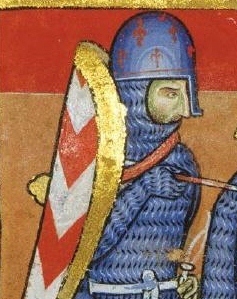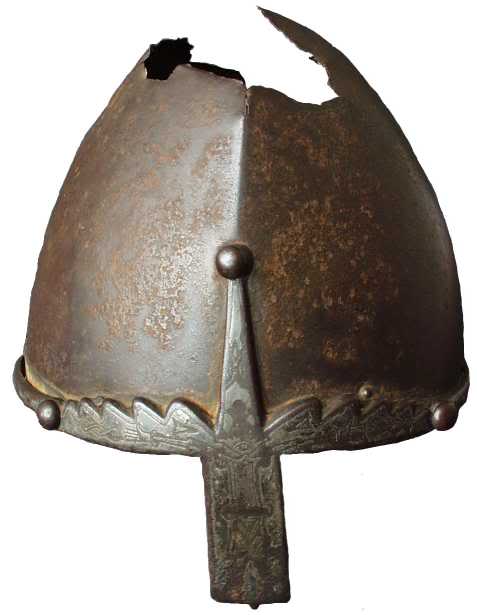Hi,
I'm looking for pictures of extant normal / nasal helms. Preferably western europe, 11th-13th century but please contribute of you have pictures of other helmets as well. Let's make a nice collection :)
I know of this one in the Kunsthostorisches Museum in Vienna (image courtesy of Wikipedia):
[ Linked Image ]
That's the only image I have so far.
I'm looking into this because I'm searching for a suitable helmet design that will work for The Battle of Hastings as well as the mid-13th century. Now that I have ordered a maille coif, it's time I started shopping for a helmet :)
Thanks! I have seen many replicas of that helmet but this is the first time I have seen the original. Good to know it's probably eastern European. I didn't know that. It's also good to know that this is apparently the brim of one helm put on another and then used as a relic (e.g. not something you'd find on the battlefield?)
In the mean time, Flickr was able to provide me with a view from the back of the helmet in my original post (link):
[ Linked Image ]
In the mean time, Flickr was able to provide me with a view from the back of the helmet in my original post (link):
[ Linked Image ]
a bit offtopic perhaps but concerns helmets nontheless.
I have recently heard that in addition to the gjermundbu helmet theare has been a few other finds, about the "visor" part of helmets from that time.
One i heard was from Tyle, denmark, and another from gotland.
Google wasnt very helpful. Does anyone have any pictures?
I have recently heard that in addition to the gjermundbu helmet theare has been a few other finds, about the "visor" part of helmets from that time.
One i heard was from Tyle, denmark, and another from gotland.
Google wasnt very helpful. Does anyone have any pictures?
On this web are helmets 10-12 century western slavonic area
http://www.curiavitkov.cz/valka21.html
http://www.curiavitkov.cz/valka21.html
Another excellent webpage for nasal helms: http://www.reenactment.de/reenactment_start/r...guide.html
Thanks all. These are good articles. I already discovered some more interesting tidbits (long live Google Translate). For example, that many nasals seem to have hooks. Even on helmets that don't have them (like the one I posted) have evidence suggesting that it did once have a hook but broke off. These hooks at the end of your nasal would be to hang your maille from I guess.
| Robert Rootslane wrote: |
| a bit offtopic perhaps but concerns helmets nontheless.
I have recently heard that in addition to the gjermundbu helmet theare has been a few other finds, about the "visor" part of helmets from that time. One i heard was from Tyle, denmark, and another from gotland. Google wasnt very helpful. Does anyone have any pictures? |
AS for the spectacle "visor" there is find from Denmark, but from Aarhus.
[ Linked Image ]
One helmet is from Lithuania. Somewhere near place called Salmas as I have heard.
[ Linked Image ]
Can anyone provide more material or info about these two?
I see that quite a few extant nasal helmets have a little hook on the end of the nasal (or, evidence that there once was a little hook). I presume that this was to attach a ventail to? I was wondering if this is an eastern European thing or if this was found in the west as well. Also, I was wondering if there was any extant artwork showing people wearing such helmets.
| Robert Rootslane wrote: |
| a bit offtopic perhaps but concerns helmets nontheless.
I have recently heard that in addition to the gjermundbu helmet theare has been a few other finds, about the "visor" part of helmets from that time. One i heard was from Tyle, denmark, and another from gotland. Google wasnt very helpful. Does anyone have any pictures? |
I have head of such finds as well. There most cringeworthy are the rumours of private collectors sitting on undocumented viking and iron age helmet finds.
Pushing this thread even more off-course:
There is at least the case of an eyebrow from a "vendel type" helmet from Uppåkra:
[ Linked Image ]
Pushing this thread even more off-course:
At first glance it looks to me to be decorated in style II, which is consistent with the styles of the late sixth and up into seventh century.
| J. Kari wrote: |
|
One helmet is from Lithuania. Somewhere near place called Salmas as I have heard. |
Hello,
This helmet is on exhibit now at Vytautas the Great War Museum. Exact finding location and circumstances are unknown. Semicircular helmet consists of two metal pieces, reinforced with an iron bar at the bottom (riveted with two rivets). A helmet is decorated with three longitudinal lines.
Lithuanian archaeologist R. Volkaite-Kulikauskiene, in her own article, about the earliest helmets in Lithuania, equate this helmet to Vendel era helmets, but for some reason this article summarizes the helmet to the 11th century. The exact analogue of the helmet is unknown. According to the form and method of manufacture very similar helmet was found in Slovenia and dated to the 5th or 6th century. In the directory of "Cf. Catalogue of the Armoury in Vienna. Volume I," are few examples of similar helmets from Sveti Vid (Dalmatian Mediterranean area (Serbia)), and Steinbrun area (eastern Austria), dated to the fifth century. This suggests, that the helmet should be dated at least from the 5th to the 7th century.
Source - http://www.vilkatlakai.lt/balt-ginkluot/almai/169
Here's one that's housed in the Nederlands Legermuseum. It's providence is Hainburg, Lower Austria. 10th-11th century, I'd say. Very typical style. Cheers!
-Gregory
[ Linked Image ]
 Attachment: 104.9 KB
Attachment: 104.9 KB
[ Download ]
-Gregory
[ Linked Image ]
[ Download ]
Another one helmet, which can be dated to the 12th century, was found near Slonim (Belarus). Attributed to Lithuanians.
Here is an article about this helmet (sadly, in Russian) - http://xxx.xxx/2010/12/08/slonimskiy-...denie.html
Here is an article about this helmet (sadly, in Russian) - http://xxx.xxx/2010/12/08/slonimskiy-...denie.html
I must confess that I'm rather fond of a nasal-helm that I've seen a few pictures of. It's main feature being that it appears to be made out of four plates riveted directly to one another (so not really a spangenhelm I guess).
And that Swordmasters site seems pretty legit, and once one figures out how to navigate it, it offers some pretty cool pictures and sources that I don't believe I've ever seen before.
And that Swordmasters site seems pretty legit, and once one figures out how to navigate it, it offers some pretty cool pictures and sources that I don't believe I've ever seen before.
To resurrect an old thread, how much evidence is there for painting or bluing nasal helmets as a preservation method or for decoration?
In the late 12th century, Bertran de Born is singing of "helms of color".
http://colecizj.easyvserver.com/povb4038.htm
Massas e brans, elms de color
E scutz trauchar e desgarnir...
This was before enclosed helms, though there were some early masks or T-nasals by then. Some of these late-12th century helms are more hemisperical than conical, but some have nasals. Red and green are the most common colors in manuscripts when a neutral or non-steel color is obvious. Some early heraldic markings are seen on late-12th century helms--crosses, fleurs, bends, frets, etc.--which seem to have been applied by paint.
[ Linked Image ]
[ Linked Image ]
[ Linked Image ]
[ Linked Image ]
[ Linked Image ]
 Attachment: 92.33 KB
Attachment: 92.33 KB

http://colecizj.easyvserver.com/povb4038.htm
Massas e brans, elms de color
E scutz trauchar e desgarnir...
This was before enclosed helms, though there were some early masks or T-nasals by then. Some of these late-12th century helms are more hemisperical than conical, but some have nasals. Red and green are the most common colors in manuscripts when a neutral or non-steel color is obvious. Some early heraldic markings are seen on late-12th century helms--crosses, fleurs, bends, frets, etc.--which seem to have been applied by paint.
[ Linked Image ]
[ Linked Image ]
[ Linked Image ]
[ Linked Image ]
[ Linked Image ]

Can someone post some of the evidence for the hooks on the nasals? I am having some trouble finding solid references to this being a widespread practice.
Have you seen this? http://www.reenactment.de/reenactment_start/r...guide.html
Thanks! This helps, and the pictures are fairly clear. I think it's interesting to note to seemingly hook-less nature of many helmets in drawings and statues. Is it possible that the hooks were removable, or that there may have been helms made with lacing holes in the nasal, which may or may not be later depicted?
Page 1 of 1
You cannot post new topics in this forumYou cannot reply to topics in this forum
You cannot edit your posts in this forum
You cannot delete your posts in this forum
You cannot vote in polls in this forum
You cannot attach files in this forum
You can download files in this forum
All contents © Copyright 2003-2006 myArmoury.com — All rights reserved
Discussion forums powered by phpBB © The phpBB Group
Switch to the Full-featured Version of the forum
Discussion forums powered by phpBB © The phpBB Group
Switch to the Full-featured Version of the forum
